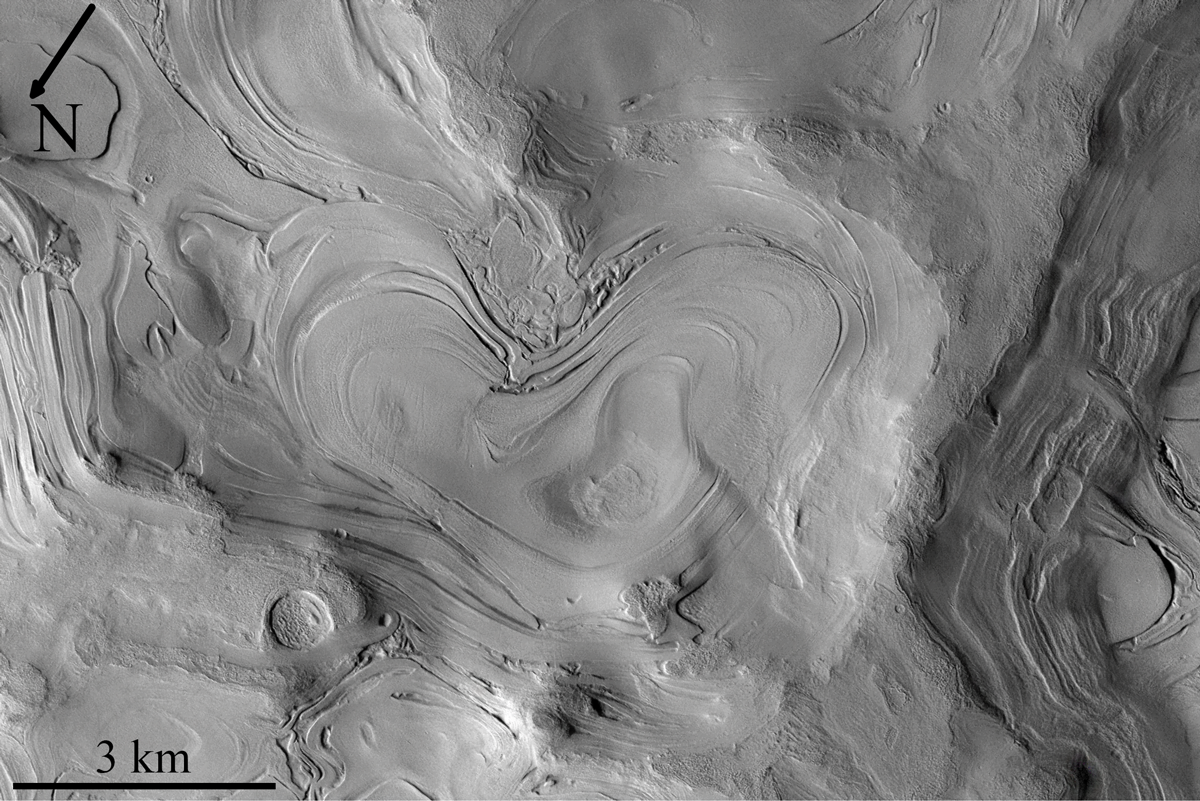Mars Valentine 2025
NASA/JPL-Caltech/Malin Space Science Systems
Subframe of the full CTX image V18_086849_1385_XN_41S306W_250204. North is to the bottom of the image and illumination is from the upper right.
Happy St. Valentine’s Day from the Mars Reconnaissance Orbiter (MRO) Context Camera (CTX)! We are celebrating this Valentine’s Day with a CTX image from the western portion of Hellas Impact Basin, the largest visible crater in the solar system.
This image shows a complex banded terrain in the form of a heart-shaped basin on the floor of Hellas Planitia at approximately 39.68 S, 306.70 W. Sometimes referred to as “taffy-pull terrain” for its swirling, gooey-looking appearance, this phenomenon was discovered in Mars Global Surveyor (MGS) Mars Orbital Camera (MOC) imagery, and has continued to be imaged and mapped by its successor, CTX. While the geologic processes behind its formation are poorly understood, the complex patterns appear to be the result of ductile deformation, which often indicates strain due to large external stresses. Some hypotheses include erosion of alternating layers of hard and soft substrate, faulting, and mass wasting.
Because of its geography and relatively thick and dusty atmosphere, Hellas Planitia is an especially difficult region of Mars to image clearly. Generally, optimal imaging times include a short seasonal window during the southern winter (Ls 55-85). This CTX image is particularly interesting in that it was taken quite a bit earlier than the optimal window (Ls=39), during a time period known for frequent dust storms in the basin. In fact, this image was just a few tens of kilometers to the east of the leading edge of a dust storm. It appears that, like on Earth, the weather is always nice before the storm!
Over the past 26 years, Malin Space Science Systems has featured other heart-shaped martian landforms on Valentine's Day in images acquired by MRO CTX and the Mars Global Surveyor (MGS) Mars Orbiter Camera (MOC). These previous examples can be viewed by clicking on the following links:
- Mars Valentine 2024—14 February 2024
- Mars Valentine 2023—14 February 2023
- Mars Valentine 2022—14 February 2022
- Mars Valentine 2021—14 February 2021
- Mars Valentine 2020—14 February 2020
- Mars Valentine 2019—14 February 2019
- Jovian and Martian Valentine 2018—14 February 2018
- Mars Valentine 2017—14 February 2017
- Mars Valentine 2016—14 February 2016
- Love from Mars—14 February 2012
- Mars is Where the Heart is—14 February 2011
- A Martian Valentine for 2009—13 February 2009
- Happy Valentine's Day from MRO CTX—14 February 2008
- Valentine 2006—14 February 2006
- Martian Valentine's Day—14 February 2005
- Happy Valentine's Day 2004—14 February 2004
- Happy Valentine's Day From Mars!—11 February 2000
- From Mars, With Love—17 June 1999
|
To cite the image(s) and caption information in a paper or report: Malin, M. C., D. A. Susko, C. Keegan, A. B. Valeh, G. T. Speth, N. O. Dominguez, and L. Posiolova (2024), Mars Valentine 2024, Malin Space Science Systems Captioned Image Release, MSSS-611, http://www.msss.com/science-images/mars-valentine-2025.php. The image(s) and caption are value-added products. MSSS personnel processed the images and wrote the caption information. While the images are in the Public Domain, NASA/JPL-Caltech/MSSS requests that you credit the source of the image(s). Please give the proper credit for use of the image(s) and/or caption. |
|
Malin Space Science Systems (MSSS) built and operates the Mars Science Laboratory (MSL) Curiosity rover Mast Camera (Mastcam) and Mars Hand Lens Imager (MAHLI) and Mars Descent Imager (MARDI), the Mars Reconnaissance Orbiter (MRO) Mars Color Imager (MARCI) and Context Camera (CTX), and the Jupiter Orbiter (JUNO) camera (Junocam). MSSS also built and operated the Mars Global Surveyor (MGS) Mars Orbiter Camera (MOC). In addition, MSSS built the Mars Odyssey (ODY) Thermal Emission Imaging Spectrometer (THEMIS) Visible (VIS) camera subsystem, which shares optics with the thermal infrared instrument and is operated at Arizona State University (ASU). MSSS also built the Mars Descent Imager (MARDI) for the Phoenix Mars Scout lander, the suite of high resolution cameras aboard the 2009 Lunar Reconnaissance Orbiter (LRO), and Origins-Spectral Interpretation-Resource Identification-Security-Regolith Explorer (OSIRIS-REX) mission. MSSS has also built and operated cameras for the Mars 2020 rover mission. |




